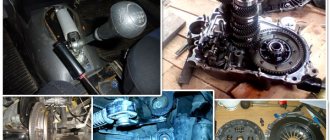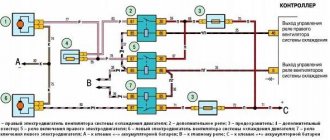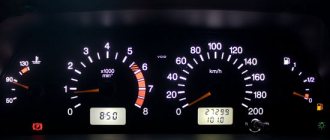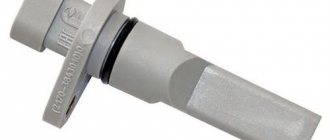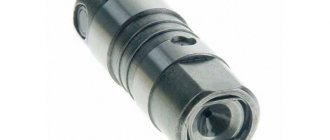The clarity of gear engagement and the operation of the entire shift mechanism often worries owners of cars with a manual transmission. A common problem is that after starting the engine, one or more gears are engaged with great effort or not completely, it is not possible to change gears, at the moment of switching on, extraneous noise is heard, unnecessary vibrations appear, etc.
We also recommend reading the article on how to repair a crack in the cylinder block or cylinder head. In this article, you will learn about various methods for repairing cracked engine block and head.
Such malfunctions appear unexpectedly, and difficulties when shifting gears can increase gradually. Speeds may be difficult to switch on “cold” and/or “hot”. It is noteworthy that gears in a manual transmission often shift normally when the engine is turned off.
Gears are difficult to engage with the engine running: possible reasons
At the very beginning, it should be noted that the inability to engage a gear with the engine not running may indicate a serious gearbox malfunction, which consists of failure of the synchronizers. The second reason may be wear or breakage of the gears. It is also possible that the components and mechanisms responsible for transmitting force from the lever in the cabin to the gearbox when selecting a gear may become jammed.
To accurately determine the causes, in the first case it will be necessary to remove the box for disassembly and subsequent troubleshooting; in the second case, it is necessary to identify and replace broken components. In some cases, it is enough to carry out their prevention: removal, lubrication and careful adjustment.
As for problematic switching when the internal combustion engine is running, then the list of the most common faults includes:
- lack of gear oil in the gearbox;
- problems with the clutch mechanism;
Causes
Whether the gear will be engaged with the engine running will depend on whether it is possible to shift into gear when the engine is stopped. If this cannot be done, most often the problem lies in the synchronizers or gears. But in any case, you will need to disassemble the box to determine the true cause.
When the speed does not turn on when the engine is running, you should look for the reason in the clutch. It could be:
- lack of oil;
- the clutch does not work at full capacity;
- There is no fluid in the drive hydraulic system.
After disconnecting the box, you can disassemble the clutch basket: problems usually come from there. It is easier to check the amount of fluid; just look into the expansion tank. This is available for those models that have a hydraulic clutch.
Low gearbox oil level
An insufficient amount of oil in the box makes the process of shifting gears extremely difficult, but the speeds must be engaged. When switching in this way, a metallic crunch is heard, and when driving in a gear, the transmission begins to make a lot of noise and “howl.”
A complete lack of lubrication in the gearbox will not allow you to change gears, since without oil the synchronizers will not be able to work properly, and the gears in the gearbox will not engage.
Any manifestation of these symptoms requires immediate cessation of operation of the vehicle and checking the transmission oil level in the gearbox. It is also necessary to inspect the gearbox for damage to the housing, oil leaks through the seals and gaskets.
It should be noted that for manual transmissions of many cars, the oil in the gearbox is filled from the factory for the entire service life. In practice, replacement is recommended every 60-80 km. mileage
It is imperative to fill only with lubricant recommended for viscosity and other characteristics. As for adding oil to the transmission, it is necessary to separately take into account the issue of compatibility with the already filled lubricant.
Problems with switching to automatic transmission
Shifting problems with automatic transmissions are not uncommon. Problems with the automatic machine arise for several reasons.
- backstage malfunction . This mechanism is the most problematic in old-type automatic transmissions. To eliminate the malfunction, the unit will need to be replaced. In most cases, it will be necessary to dismantle the gearbox for these purposes;
- insufficient oil level . The presence of lubricant leaks on the automatic transmission housing may indicate wear of the sealing gaskets, which are not difficult to replace yourself. After this, you need to change the oil in the box. Also, owners of cars with an automatic transmission are recommended to visually inspect the gearbox for oil leaks at least once every 2000 km;
- problems with the transmission control unit can ultimately cause the automatic transmission to completely lock up. To fix the problem, you will need to replace the failed mechanism and thoroughly inspect the electrical part of the gearbox.
Important! To solve problems with automatic transmission, it is recommended to conduct computer diagnostics of transmission faults.
Clutch faults
Simply put, the clutch is a mechanism that serves to transmit the torque of the internal combustion engine to the transmission, and also opens the engine and transmission so that gear can be changed. Failure of individual components of this unit may make it impossible to shift gears while the engine is running.
We also recommend reading the article about devices for starting the engine with a discharged battery. From this article you will learn about the features and selection of boosters (starter chargers).
Brake fluid leaks
The design of many modern cars assumes that the working fluid for the clutch is brake fluid. If there is not enough fluid in the clutch drive hydraulic system, then the clutch will not engage fully.
In this case, the gears will engage slowly or not engage at all. For an initial check, you should look at the fluid level in the reservoir. If the level is low, it is necessary to check for leaks, eliminate defects and bleed the clutch.
If the fluid level is normal and no other reasons have been identified, you will need to remove the gearbox to inspect the clutch elements. Usually, when you try to turn on the speed and this mechanism breaks down, no loud grinding metallic sounds are heard from the gearbox itself.
Release bearing
Gears may not engage or may not engage fully if the fault is related to the clutch basket. The release bearing may also be the cause. If the specified bearing does not move freely along the input shaft or is jammed, then replacement of the part is necessary.
It is necessary to separately add that the primary sign of problems with the release valve is the appearance of a rustling or distinct hum when the car is running. The noise appears only when the clutch pedal is pressed to the floor. Such extraneous sounds can be present both on a cold car and on a warm one. After releasing the clutch pedal, the noise should disappear. A jammed release lever will not allow the clutch to engage, which complicates gear shifting and can also lead to rapid wear and destruction of other elements of the clutch mechanism.
How often do you change the clutch disc?
There are no specific regulations here. Clutch disc life is a subjective concept. It all depends on the load - whether you used a trailer, how much you overloaded the car and how often you drove off with wheel slipping. Each blow from the flywheel falls precisely on the clutch disc, because its main task is to transmit torque, and to do this as smoothly as possible. The resource can range from 30 to 200 or more thousand kilometers. The service life directly depends on the driving style and vehicle loading conditions.
Automatic transmission does not change gears: reasons
Depending on the brand and manufacturer, automatic transmissions may have some differences, but the main causes of shifting problems are common. Let's start with the fact that the most common mistake leading to automatic transmission failure is turning on the drive mode “D” without stopping when moving in reverse. The same can be said about engaging “R” when driving forward.
You need to understand that “neutral” is a mode that unlocks the wheels for the possibility of short-term towing or moving the car in the event of some kind of malfunction. For an automatic transmission, there is no need to use it during everyday use of the car, as this causes increased wear.
Why don't the gears turn on when the engine is running?
The clarity of gear engagement and the operation of the entire shift mechanism often worries owners of cars with a manual transmission. A common problem is that after starting the engine, one or more gears are engaged with great effort or not completely, it is not possible to change gears, at the moment of switching on, extraneous noise is heard, unnecessary vibrations appear, etc.
Such malfunctions appear unexpectedly, and difficulties when shifting gears can increase gradually. Speeds may be difficult to switch on “cold” and/or “hot”. It is noteworthy that gears in a manual transmission often shift normally when the engine is turned off.
Why are gear shifts slow and unclear?
We looked at gear shifting faults related to the clutch and gearbox. But the condition of the backstage plays an equally important role in the smoothness of the change of steps. According to the type of design, all types of gear shift mechanisms can be divided into 2 types:
- hinged-traction type. The shift lever is connected to the gear selection lever inside the gearbox through a system of rods and articulated joints. In a rocker of this type, the bushings at the junctions of the elements and the liners of the base of the rocker often wear out. If the reaction of the gear selection mechanism under the hood is much less than the amplitude of movement of the lever, then the cause of the unclear shift should be sought in the cabin. Remove the casing and inspect the mechanism for worn rubber seals, plastic or metal bushings. Most often, the cause of tight and unclear shifts is the wear of the section of the rocker from the cabin rod to the gear selector lever inside the gearbox. The problem is solved by partially replacing the mechanism and installing a backstage repair kit. In critical cases, some gears are not engaged at all, instead of 1, 3 is engaged, and the 2nd stage is easily confused with 4;
- cable drive. The shift lever in the cabin is connected to the gear selection lever inside the gearbox through a system of rods and cables. If the cables become sour or freeze in winter, the gears are difficult to shift. When the cables are stretched, the lever stroke increases, so shifts become tight and unclear.
The box “crunches” when switching
Crunching is the characteristic extraneous sound that occurs when changing gears. Reasons for this phenomenon:
- malfunctions of the clutch and its release drive, due to which, when the pedal is depressed, the driven disk remains in engagement with the flywheel (in such cases it is often said that the clutch “drives”). Sounds when changing gears are often accompanied by a tight movement of the rocker, so to change gears you need to apply quite a lot of force;
- insufficient amount of oil in the gearbox;
- incorrect adjustment of the clutch release cable drive;
- wear of synchronizers in the gearbox.
Malfunctions when turning on gears and their elimination
The main components of a modern car are characterized by the same operating principles, despite significant differences in their design. In particular, this also applies to manual transmissions (if we do not consider rear-wheel drive cars, in which the lever is connected directly to the transmission).
Front-wheel drive vehicles can have either a longitudinal or transverse gearbox. In the latter case, a link is used for communication between the motor and the gearbox; on some models (for example, on the Ladovsky Vesta and Kalina) a cable drive is used. It is considered simpler and more reliable, but this design is not without its drawbacks and can fail.
So, let's look at the main reasons why gears do not engage when the engine is running.
Traction, drawstring
Since we have already mentioned domestic cars with a transverse power unit (from the “Nine” to the “Priora”), then when the above-mentioned problem appears, it is first necessary to begin the search for the culprits with these mechanisms.
If you notice that when the car starts moving, the gearbox lever rattles chaotically and unpleasantly, most likely it is the rocker that has flown out of its mounting location. This type of malfunction occurs especially often on cars of the Lada Samara family of the first two generations. The solution is to replace the link or fastener element with new ones. We can say that this is the most obvious and easily fixable malfunction of this kind.
Cable
On cars of later years of production, a cable is used instead of a rocker. If this cable breaks, you will not be able to engage the gear, but not only with the engine running, but also with the engine turned off. This is what will indicate that the drive cable is the likely culprit. Replacing it is not difficult, and it is inexpensive compared to other components and parts.
Insufficient transmission oil level
The box, like the engine, may lose its seal, which will lead to lubricant leakage. If there is a deficiency of it, you will feel that the gears are “stuck” with strain, since the engagement of the gears in the absence of oil occurs with great difficulty. If the problem is not corrected in time, the synchronizers will eventually fail and costly repairs will be required.
Therefore, when the first difficulties with switching appear, first check the oil level in the box, and if it is below normal, inspect the transmission for oil stains. If they are detected, you can reduce the amount of work to be done because you will know which gasket or seal needs to be replaced. However, it is recommended to check the integrity of the seals on both sides of the box.
Motor mounting cushion
Many drivers are not aware that due to severely deformed cushions, not only the engine, but also the gearbox will suffer. And this phenomenon is typical for both types of transmissions, manual and automatic.
There are car models on which the boxes are installed on special supports, which must be periodically checked for integrity and, if necessary, replaced. The easiest way to check is to make sure that the engine does not oscillate in the longitudinal direction when idling and increasing speed. If the cushions sag significantly, the motor also lowers, which can lead to breakage of the linkage or jamming of the input shaft rotation. The problem is solved by replacing deformed pillows.
Fork
So far we have considered fairly simple breakdowns that do not require dismantling the gearbox or clutch. It's time to move on to more serious things - clutch problems, due to which the gearbox does not engage while the engine is running.
Most modern cars, regardless of the type of drive, front or rear, are equipped with gearboxes in which the gears are engaged using a hydraulic drive. The triggering mechanism is as follows: when you press the clutch pedal, the release piston is set in motion, creating excess pressure in the drive line, under the influence of which the fork moves to the side and the disc is disconnected from the shaft.

